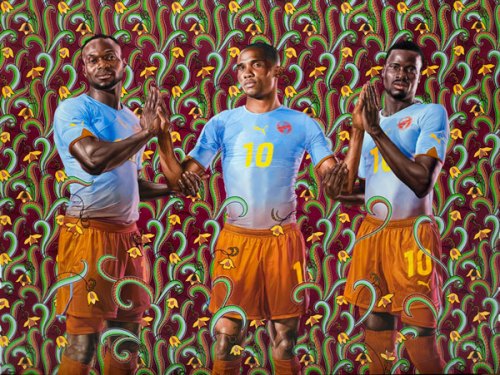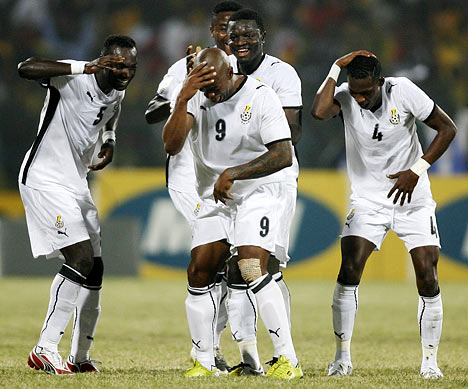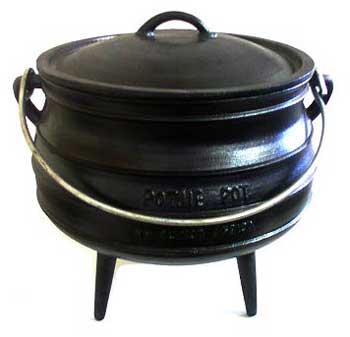
The German shoe and sportswear company, Puma, sponsors at least 12 African national football teams–five of which qualified for the 2010 World Cup. To commemorate the World Cup year (and because it is good PR and to sell shirts), Puma commissioned artist Kehinde Wiley to create four new works of arts inspired by the footbal stars Samuel Eto’o of Cameroon, John Mensah of Ghana and Emmanuel Eboué of Ivory Coast. Wiley painted individual portraits of the players and a fourth painting (above) of the three players “symbolizing the united countries of Africa.” The players are wearing the “Unity” kit, a limited edition uniform designed to be a third kit (apart from home and away kits) shared by all African teams, symbolizing unity.
Here‘s a link to a video of Wiley at work on the project with Mensah, Eboue and Eto’o.
The paintings will be exhibited during the World Cup in South Africa.
Tag: Cote d’Ivoire

Can Africa’s World Cup qualifiers respond and take their game to a higher level. There were precious few clues in Angola to suggest they could. One would tend not to identify Pussy Cats, Super Turkeys and Tuskless Elephants as World Cup winning species, but if Cameroon, Nigeria and Cote d’Ivoire apply themselves like Black Stars they could move beyond the shadow of the Pharoahs and rediscover their fierceness.
The Black Stars were not predicted to shine in Angola. A significant number of their established names were injured or sulking. But with Milovan Rajevec, an old Yugoslav in command of the x’s and o’s, and a squad of U20 World Cup winners to choose from, folks should not have been so surprised. There has been plenty of talk of those who filled the boots of Appiah, Essien, Mensah and Muntari. Agyemang-Badu, Asamoah, Ayew and Inkoom are now household names, the equal of any Pharoah or sulking star. Ghana’s graduates will give pause to Australia, Germany and Serbia, who should note the Pharoahs may not have been so pleased with themselves if Rajevec had also introduced goalkeeper Daniel Adjei and centre forward Dominic Adiyah. Ghana were just an Adjei fingertip and an Adiyah toe poke away from closing down the party at Club Pharoah.
So how will Les Éléphants, Les Lions Indomptables and Super Eagles respond to their inglorious exits from Angola? Will they promote from their junior ranks? Will they advertise for an old partizan with a chalkboard? They could do all of the above, but nothing will change for them if the likes of Drogba, Eto’s and Yakubu don’t believe.
Pot Observations
TEN POT OBSERVATIONS.

1. FIFA got the seedings right. Pot 1 seeds earned their ranking. France did not. France’s final appearance was four years ago.
2. Chile, Paraguay and Uruguay have come out of the pot alignment better than most. Each of the smaller South American nations will avoid the big five African qualifiers in the 1st Round.
3. Argentina and Brazil cannot avoid the African qualifiers from Pot 3. The seeds for two potential Groups of Death have now been sown. Has FIFA put Brazil at risk for an early bath?
4. The most frightening Group of Death would be: Brazil, Mexico, Côte d’Ivoire and Portugal.
5. The dark horse of Pot 2 is Honduras.
Everybody is linking to this video of a young boy enjoying the Brazil-Italy game on Sunday in Pretoria.
Also on Sunday the US finally showed up against Egypt. Apparently before the match, the president of the United States Soccer Federation, Sunil Gulati, received up to 200 “mostly angry” emails demanding that US coach Bob Bradley be fired. The angry emails might be back Wednesday after night.
[NY Times]
Japanese free kick specialist Shunsuke Nakamura is leaving Celtic in Scotland for Espanyol. (Remember this freekick?)
[The Guardian]
Cote d’Ivorian international, Aruna Dindane, who could be one of the break-out stars of 2010 in South Africa (Cote d’Ivoire is on course to qualify), is leaving French club Lens for Tottenham Hotspurs in London.
[101 Great Goals]
Most African players when they go “overseas” go to Europe, or more recently, to Eastern Europe, Russia or even Asia (especially Southeast Asia). Now more are going to the United States. African representation in Major League Soccer “… has mushroomed since the league’s first season, in 1996. There were between 10 African-born players (in 2003) and 16 (in 1996) for its first 11 seasons; in the last three years, there were 28 (2007), 34 (2008) and 32 (2009).” Some of these players–like Chicago Fire defender Bakary Soumare and Kei Kamara of the Houston Dynamo for Sierra Leone–are even representing their countries in World Cup qualifiers.
[NY Times]